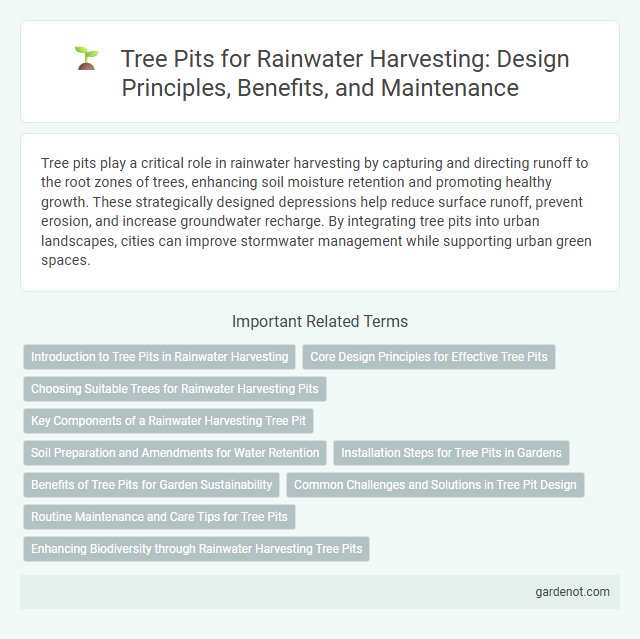Tree pits play a critical role in rainwater harvesting by capturing and directing runoff to the root zones of trees, enhancing soil moisture retention and promoting healthy growth. These strategically designed depressions help reduce surface runoff, prevent erosion, and increase groundwater recharge. By integrating tree pits into urban landscapes, cities can improve stormwater management while supporting urban green spaces.
Introduction to Tree Pits in Rainwater Harvesting
Tree pits in rainwater harvesting serve as localized recharge zones that capture and infiltrate stormwater directly into the soil, reducing runoff and enhancing groundwater replenishment. These depressions, strategically placed around trees, collect rainwater from impervious surfaces, improving tree health and urban microclimates while mitigating erosion. Incorporating tree pits with permeable materials and proper grading maximizes water absorption efficiency and supports sustainable landscape management.
Core Design Principles for Effective Tree Pits
Tree pit design must prioritize water infiltration and retention by incorporating permeable materials like gravel or sand to enhance rainwater absorption. Proper sizing based on soil type and tree species ensures optimal root access to moisture, preventing waterlogging and promoting healthy growth. Integrating overflow mechanisms prevents pooling while directing excess runoff to adjacent recharge zones, maximizing rainwater harvesting efficiency.
Choosing Suitable Trees for Rainwater Harvesting Pits
Selecting tree species with deep root systems and high drought tolerance enhances the effectiveness of rainwater harvesting pits. Native trees such as Acacia, Neem, and Banyan are ideal due to their adaptability to local soil conditions and efficient water uptake. Proper species selection maximizes water infiltration, reduces runoff, and supports sustainable urban greenery.
Key Components of a Rainwater Harvesting Tree Pit
A rainwater harvesting tree pit includes key components such as a permeable basin to capture runoff, organic mulch to retain moisture, and an infiltration layer often composed of sand or gravel to facilitate water percolation into the soil. A filter layer prevents debris and contaminants from entering the pit, while root barriers protect surrounding infrastructure. These elements work synergistically to maximize water retention and support healthy tree growth in urban landscapes.
Soil Preparation and Amendments for Water Retention
Tree pit soil preparation for rainwater harvesting involves enhancing soil texture and structure to maximize water retention and promote healthy root growth. Incorporating organic amendments such as compost, biochar, and mulch improves soil porosity, moisture-holding capacity, and nutrient availability. Proper soil preparation reduces runoff, allowing efficient infiltration and sustained water supply during dry periods.
Installation Steps for Tree Pits in Gardens
Install tree pits by first selecting appropriate locations with good soil permeability and minimal root interference to maximize rainwater absorption. Excavate pits measuring approximately 60 cm in diameter and 45 cm deep, ensuring the bottom is level to retain water effectively. Fill the base with a layer of coarse gravel for drainage, then backfill with nutrient-rich topsoil mixed with compost, and finally, create a slight depression around the tree to capture and hold rainwater efficiently.
Benefits of Tree Pits for Garden Sustainability
Tree pits enhance garden sustainability by efficiently capturing and storing rainwater, reducing runoff and improving groundwater recharge. Their design promotes healthy root development and minimizes soil erosion while providing essential moisture during dry periods. Incorporating tree pits supports urban green spaces by fostering resilient plant growth and mitigating the urban heat island effect.
Common Challenges and Solutions in Tree Pit Design
Tree pit design often faces challenges such as poor drainage, soil compaction, and insufficient water infiltration, which hinder effective rainwater harvesting and tree growth. Solutions include incorporating permeable materials, installing proper drainage layers, and using engineered soil mixes to enhance water retention and root aeration. Proper tree pit design ensures optimal rainwater capture, reduces runoff, and promotes healthy urban vegetation.
Routine Maintenance and Care Tips for Tree Pits
Routine maintenance of tree pits in rainwater harvesting systems involves regularly removing debris and sediment to prevent clogging and ensure efficient water infiltration. Inspecting the soil condition and replenishing organic mulch promotes healthy root growth and moisture retention. Periodic checks for pest infestations and structural damages help maintain optimal functionality and longevity of the tree pits.
Enhancing Biodiversity through Rainwater Harvesting Tree Pits
Tree pits designed for rainwater harvesting capture and infiltrate runoff, promoting soil moisture retention that supports diverse plant and microbial life. By creating microhabitats with improved water availability, these tree pits contribute to urban biodiversity and sustain native species. Enhanced ecosystem services such as reduced urban heat and improved air quality result from the increased vegetative health enabled by rainwater-harvesting tree pits.
Tree pit Infographic

 gardenot.com
gardenot.com